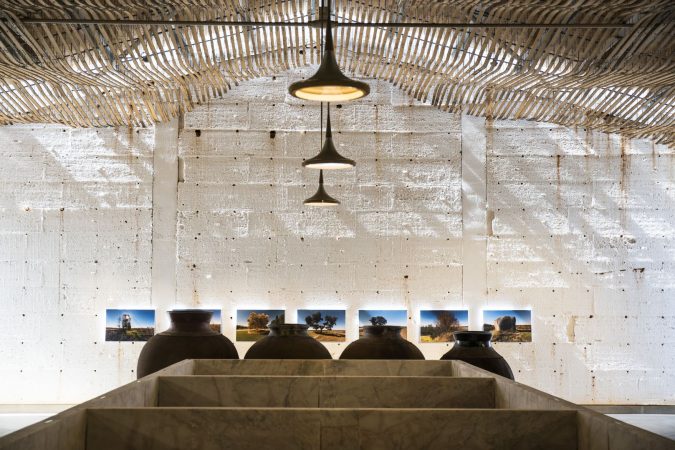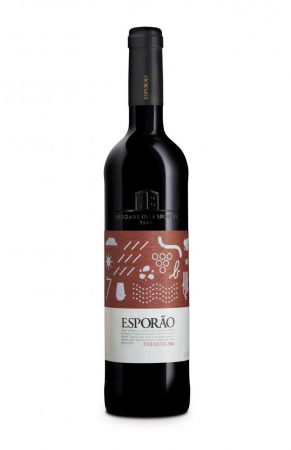Going bio: Esporão reaps benefits of organic wine
The Esporão group, one of the most deep-rooted and successful names in the Portuguese winemaking sector, is now reaping the fruits of a decade’s worth of converting its activity to biological production. At the iconic property in Reguengos de Monsaraz, 30% of the 475 hectares of vineyards and the entire olive grove are already certified, and the aim is for all the premium wines to grow this way – more genuine and purer than ever, according to the mentors behind the brand’s renovation – until 2021. The first bio bottles date from 2015, and this year, the second white and red vintages land on the market
Challenged to scrutinise the future of Esporão on the horizon, João Roquette, newly arrived at the helm of the group at age 32 and with a vibrant experience as a musician and producer, decided to look to the ground. More specifically, to the soil of Herdade do Esporão. What was it made of? What was its relationship with the vines? How and where could it be improved in favour of plant nutrition without the need for synthetic products?
It was 2007, and over the following years, many changes took place after a new vision of the estate – where only the grapes for the brand’s top-of-the-range wines are grown – and a clear intention: move from integrated production to the biological production method. In pursuit of a more authentic, more raw wine without the embellishments of wood, they should be able to tell the very specific stories of each place in this Alentejo property steeped in history, purchased in 1973 by José Roquette and Joaquim Bandeira.

The essence of the grape, from the top to the bottom of the glass, like an ever-original song, stripped of notes that detract from the essential… Yes, we might be being a tad romantic, and no, we didn’t fall into any of the concrete tulips where the nectars gain soul after their journey from the vines bearing the organic seal. The first red harvest imbued with this philosophy was the 2015, with the white following a year later, and both reaching the market in 2017. This year is the turn of the second harvests – the Esporão Colheita Tinto 2016 and the Esporão Colheita Branco 2017.
This is proof that, sometimes, one should change a winning team – if we’re talking sayings, we could also add that change can be a good thing –, because the strategy is having “very positive results”. It even gets the approval and encouragement of the elders, among whom is José Roquette, the father of the man behind the current transformations and who, in a video on the group’s website, speaks enthusiastically about this “return to the roots”.
Calling it a revolution would be excessive, because the agricultural practices at Herdade do Esporão already included sustainability concerns. But the goal of making the whole property certified in biological production – a category in which the entirety of the olive grove (100 hectares) has been classified since 2013 – entails new methods and new mentalities, with profound and visible impact, as the agricultural director of Esporão, Amândio Rodrigues, recently explained, and showed, to Essential Business.
“All of us, from the management team to the field-work teams, drink in this ideology of wanting to make products as healthy as possible, of making the best products provided by nature and doing so in an inspiring way,” notes the director, convinced that “this is the future” and that “this will serve as an example for many people”.
This is “by far” the largest project of its kind currently underway in Portugal, he adds. Of his knowledge, the most that exists in terms of the biological certification of vines are “very small” initiatives. Until now, all signs indicate that this is the right choice. Having worked at Herdade do Esporão for 30 years, Amândio Rodrigues highlights that, with this move to biological production, “we didn’t have any drop in production, nor did it become more expensive”. Naturally, “there are more costs with soil maintenance, but in terms of phytopharmacy costs, it is very different, because chemical products are very expensive”.
 Bats: the anti-plague army
Bats: the anti-plague army
But let’s start by giving the most kudos to those who deserve it in this story. They are recognised in a photographic exhibition in the foyer of the estate’s wine tourism building: large and small insects, as well as their “families and friends”, as the caption reads, a note of thanks from the hosts to all creatures for their role in keeping the vines in their healthy state. Missing in this series of photographs, for circumstantial reasons, are the bats. Many dozens – hundreds, even – fly at dusk or at night, doing what they most enjoy: eating the enemy insects and plagues of the vineyards.
Amândio Rodrigues admits he was somewhat sceptical at first, but when the analysis of the unusual mammals’ faeces confirmed that their diet is very convenient for the interests of winemaking, he gave the green light to create new shelters for the species, which became part of the army of “helpers” that support the delicate balance between the plagues that harm the vines (especially grape berry moths, mites and green leafhoppers) and others that feed on them.
This, however, is just a chapter in the dense compendium of how to encourage biodiversity and the biological production that has been applied to the property in the last 10 years. An important step in this decision, taken in 2011, was to stop using herbicides to control infestations. They moved on to a “war” with other weapons, less aggressive to the environment and, mainly, much more creative: from using pheromones to sexually confuse some of the plagues to the use of drones, through to planting legumes such as broad beans and yellow lupins (green manure…) between the rows of vines to benefit the soil and keep the plagues and respective predators in those lines, leaving the vines alone… Everything goes, as long as it is natural.
Other examples include planting vegetation cover in the vineyards, which includes charlock and phacelia and is very attractive to pollinators. Or creating hedges, especially for the period of vegetative rest when one can’t rely on crop cover, with olive trees, strawberry trees, pomegranate trees and others that form ecological passageways, not only sheltering the plagues and their predators, but also blocking the scorching Alentejo wind from dehydrating the bunches.
“Since 2013, in all the new vines [essentially, the restructuring of old vines within the estate], we created biodiverse hedges: every 50 metres, instead of having a row of vines, we have a row of shrub vegetation (80% of rose bushes, honeysuckle and blackberry bramble, and the other 20% comprising laurel, elder, rosemary…),” adds the agricultural director of Esporão, with a visible appreciation of the work done, which, furthermore, increases the beauty of the property that also features a dam.
Drones aid precision winemaking
The biological production method is being applied to all the properties in the Esporão group, from Quinta dos Murças (155 hectares in the Douro, acquired in 2008, where the originality of the vines laid out vertically on the hillside stands out on the landscape) to the land bought recently in the Portalegre area, through to Herdade do Esporão and the area located in the neighbouring Herdade dos Perdigões (on the other side of Reguengos).
The process has been developed with measures that are sowed in a timely manner to reap medium-term rewards. “Because this is a gradual process, there has to be a reconversion period of three years, even without certification, complying with all the rules, and only in the fourth year can one have that classification,” explains Amândio Rodrigues, who informs us that both the estate’s forests and the animal component entered the reconversion phase in 2017.
“Esporão’s biggest concern in the last decade has been the soil,” notes the head of agriculture. He is also pleased to tell us that, “from 2002 until today, with our natural agricultural practices alone, we have managed to more than double the level of organic material of our land”.
The land is detoxified, revived and more profoundly understood with the help of new technologies. Here, it is worth highlighting the geological study of the vineyard, undertaken three years ago, which identified seven different types of soil and described its strengths and weaknesses in detail. In a similar way, using drones enables them to understand the vigour – or lack thereof – of the soils through a single aerial picture using infrared beams. The systems overall have all been computerised, which allows them to cross-reference data and anticipate issues and solutions.
These tools allow the practice of precision viticulture, i.e. knowing the profile of each parcel of land, going into the detail of fertilising only where is proven necessary, acting very (extremely) locally. Put simply, you could say it is knowing every nook and cranny like never before. This is how the Canto do Zé Cruz vines, the Palmeiras vines and the vines of other parcels in the estate were born, all of which have their own profiles. They were studied and developed specifically, and their names come from the likes of the name of their neighbouring landowner, or the shepherd whose flock fed there…
“Knowing each area of the property so well allows us to decide how we are going to act in each of them, and in that way saving and freeing up many resources to intervene in other areas,” sums up the agricultural director. On this note, he also recalls the re-use of all waste produced at the estate, from the stalks of the grapes harvested manually and the olive tree leaves that result from the olive pressing and pomace (the pips are used in the boilers to heat the water), to the residues of the garden pruning or the organic scraps from the wine tourism kitchen. Everything ends up back in the primordial ground, thus closing the cycle.
A top-of-the-range, old-fashioned winery
The top-class wines that Herdade do Esporão creates with exclusive grapes now have their own winery, Adega dos Lagares, built around three years ago with adobe walls and barrel staves lending a strong visual impact to the ceiling and the door. Inside, the central area exhibits several marble lagares (concrete vessels where the grapes are treaded) that stand on the earth floor. Fermentation happens right next to it, in large concrete tulips. This is where all the organically grown grapes end up, both those from certified plots and those that are yet to gain the distinctive stamp. For this reason, they take completely separate routes in the winemaking process.
It is worth noting that the resulting wines of the grapes that come from producers outside the property (around 700 hectares), which are used to make the other ranges not considered superior, are made in another complex with two wineries, for white and red.
Adega dos Lagares has another obvious point of interest for visitors through the estate’s wine tourism programmes: seven huge amphorae – talhas – that bore witness to the simple and pure way in which the Romans made their wine many centuries ago (Esporão has a slightly more updated version on the market).
“The point of our Vinho da Talha is to recover that ancient tradition, and it is made from grapes from a specific area of the Alentejo, Granja-Amareleja. They are very old vines indeed, most of them ungrafted, i.e. vines that withstood the phylloxera devastation in Europe,” explains Amândio Rodrigues. He adds that the talhas in the winery were either purchased or had been abandoned in the region.
Effects of temperatures and plagues analysed in detail
In 2010 and last year, the Esporão group acquired several dozen hectares in two properties located further north in the Alentejo, in the Portalegre region, more specifically in the São Mamede hills and in Castelo de Vide. The geographical deviation was no accident: the areas in question are fresher and have more rainfall than the estate in Reguengos, and are already an answer to the concerns that arise from the current climate changes. “It is a more pressing situation for the whites, which are wines that suffer more quickly with weather changes; they need a bit more freshness,” confirms Amândio Rodrigues.
This issue comprises one of the directives in the (experimental) ampelographic field, which was created at Herdade do Esporão in 2010, following a protocol with the National Institute for Agrarian and Veterinarian Research (INIAV). These are around 10 hectares comprising 189 grape varieties, each one with 112 plants. Another function of the field is to understand the resistance of the various varieties to disease and plagues, because reactions can be very different. “There are varieties that are heavily attacked, and next to them are others that resist very well.” Understanding the oenological potential of each variety is, of course, another objective of this project.










